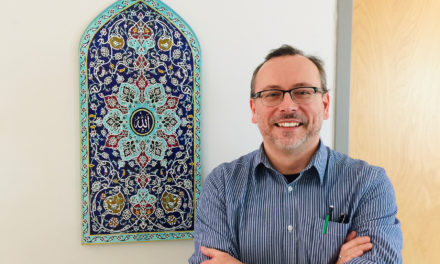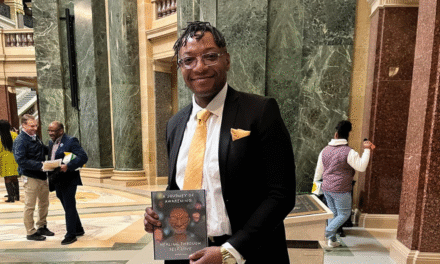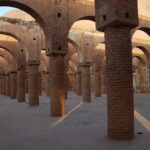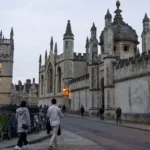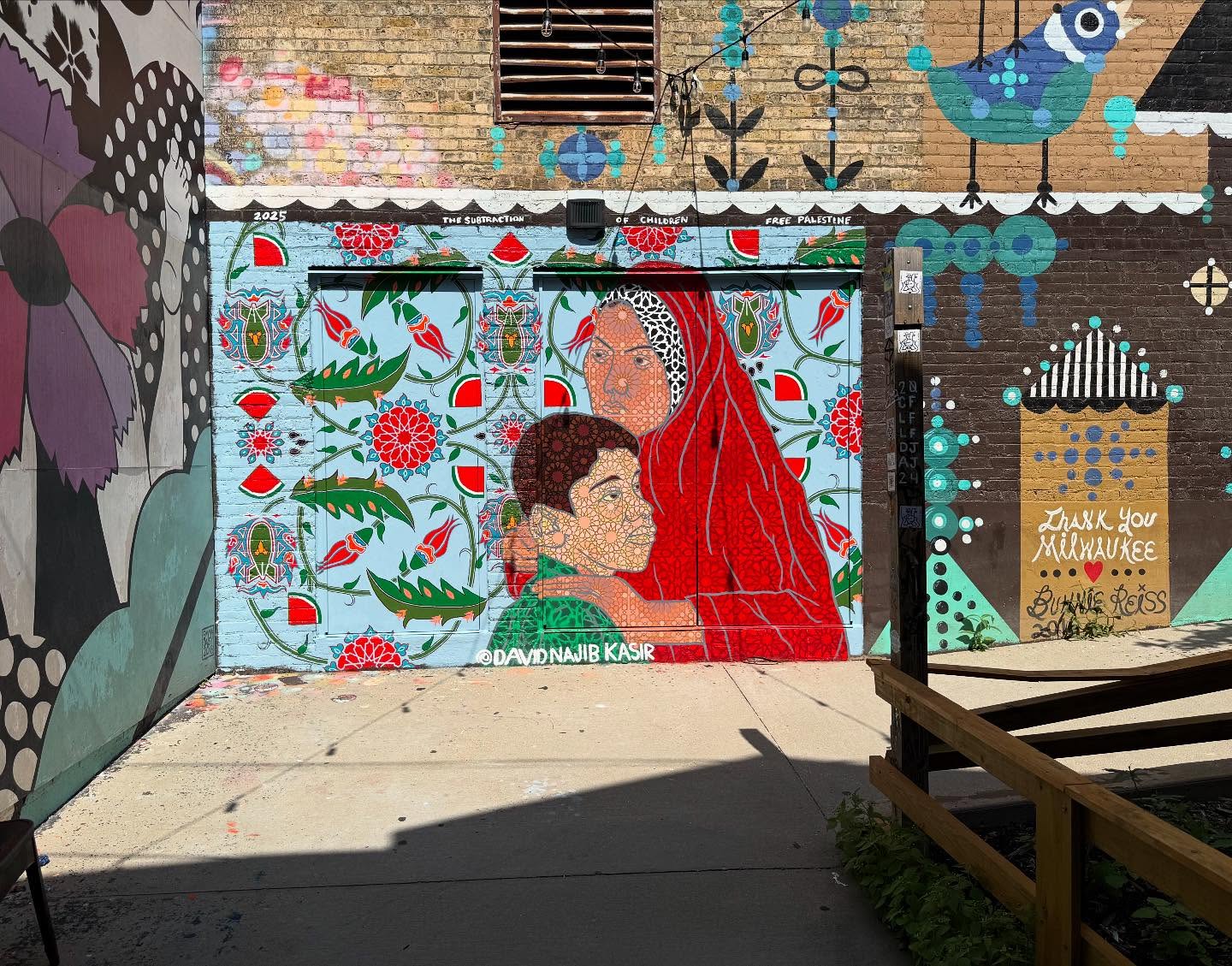
Photos courtesy of David Najib Kasir
The East Side business improvement district offered Kasir the opportunity to paint a new mural after a previous one had been obscured from view. “The Subtration of Children” was completed in mid July at Black Cat Alley.
Earlier this month, Milwaukee’s David Najib Kasir installed his latest public mural, The Subtraction of Children, depicting the painful human cost of Benjamin Netanyahu’s military campaign in Gaza. The mural is not Kasir’s first artwork representing the dilemma of Palestinians or other Arabs in a media and political culture that disregards their humanity. He remains guided by the maxim he learned at Milwaukee Institute of Art and Design (MIAD) from his instructor, the late John Bitticks.

Photo by Andre Saint Louis
Artist David Najib Kasir art changes the narrative depicted in the media.
“He taught me the importance of telling the truth, of being honest,” Kasir said. “So much art is an intellectual sort of posturing. He taught me that art has more power when it tells the truth. I do the work that concerns me and others around me.”
Kasir was born in 1977, two years after his parents arrived in Chicago. His father, a refugee from Saddam Hussein’s regime in Iraq, met his mother in Syria. “My family was a family of immigrants. We didn’t speak English very well. I understood that my sister and I were different than the other kids in school,” Kasir said.
The seed of his career as an artist might have been planted as early as kindergarten. He remembers the day that parents were invited to his school.
“My mom was there. All the kids were coloring in coloring books, and I was the only one who stayed within the lines and chose the right colors for the characters. It was an awareness that I could do something other kids couldn’t. It grew from there.”
Visiting Syria with his family as a teenager, he became fascinated with zellij, the mosaic patterns of tessellations and polygons, wedges and stars, found across the Islamic world in architecture, furniture and household objects.
“I knew I wanted to use those patterns in my work but at the time I had no reason to use them. There has to be truth in whatever I use in my work,” he said.
Many of his paintings melding the patterned geometry of zellij with images inspired by one of his favorite European artists, Käthe Kollwitz, a German Expressionist from the early 20th century. “Her paintings of loss and suffering had a huge impact on me,” Kasir explains. Her depiction of the human form, the worried lines on faces, the grieving figures of parents who lost their children during World War I, “show the emotions that art can evoke,” he said.
Kollwitz and zellij converged in his art after 2011 with the outbreak of the Syrian Civil War. “It was my mother’s homeland, my second country,” Kasir said. “I was frustrated by the way the media didn’t cover the subject, ignoring the horror that was happening.” With zellij patterns and troubled human faces, he began “to create work to raise awareness of what was happening to my loved ones and former neighbors, pushed from their homes and forced to become refugees. I wanted people to understand!”
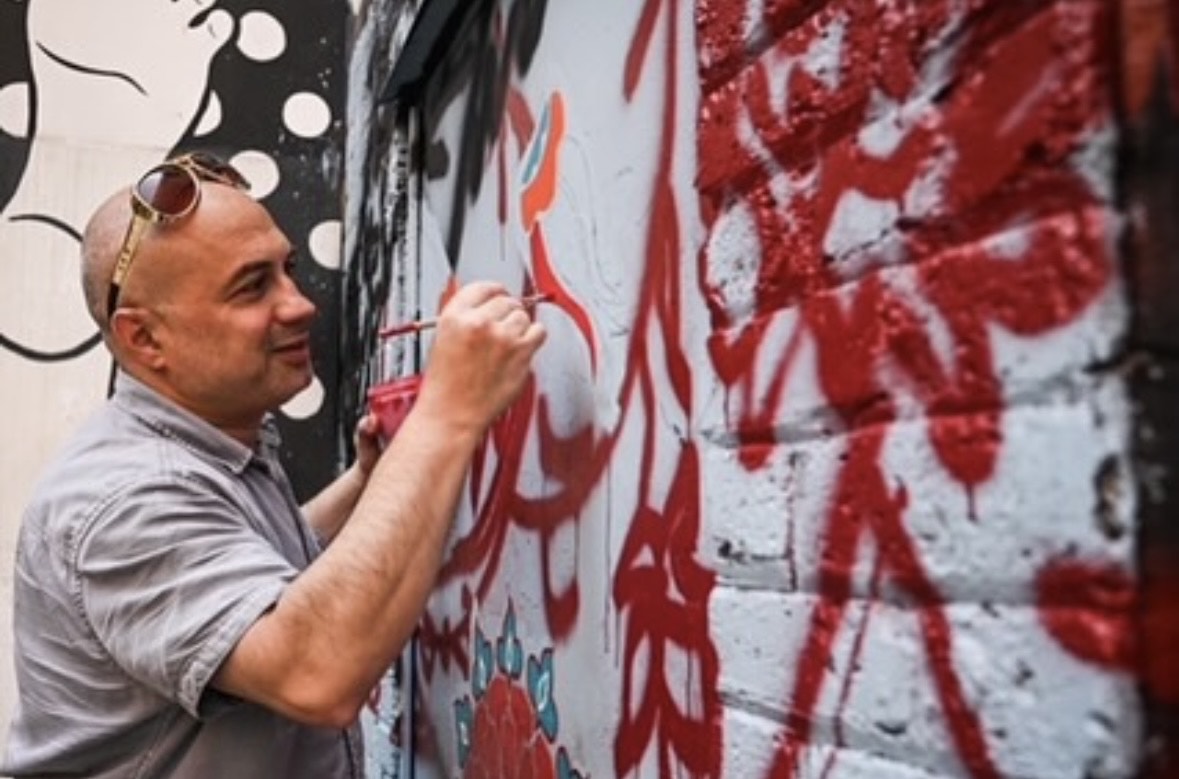
Photo by Andre Saint Louis
With only a quick tutorial for context, Kasir’s paintings and murals grant the viewer empathy for the victims of recent wars in the Middle East and can easily rise to embrace universal themes.
“As an Arab American, I started to realize how Arab culture was depicted in the media. It was always as a threat, as terrorists,” he said. “I knew that narrative was purposeful. I try to use my work to fight against that narrative. We are human beings who love our children and our parents as much as you do.”
In 2018 Kasir was asked to paint a mural for Black Cat Alley on Milwaukee’s east side. Supported by the neighborhood’s business improvement district, Black Cat Alley is a block-long alley behind the historic Oriental Theater that was once the site of crime and gang graffiti. Since 2016, it has been a curated canvas in brick and mortar for local mural artists and has become a tourist attraction.
Kasir’s mural depicted the Syrian refugee crisis in the form of a mother and her two children. “The U.S. government was already trying to have us believe that refugees and immigrants were a problem,” he explained. “I wanted to fight against that, to help people realize that this country’s policies helped create those refugees, and that we have a responsibility for them. The mural was there for years. I got messages from random people telling me how much it meant to them, how they connected to it.”
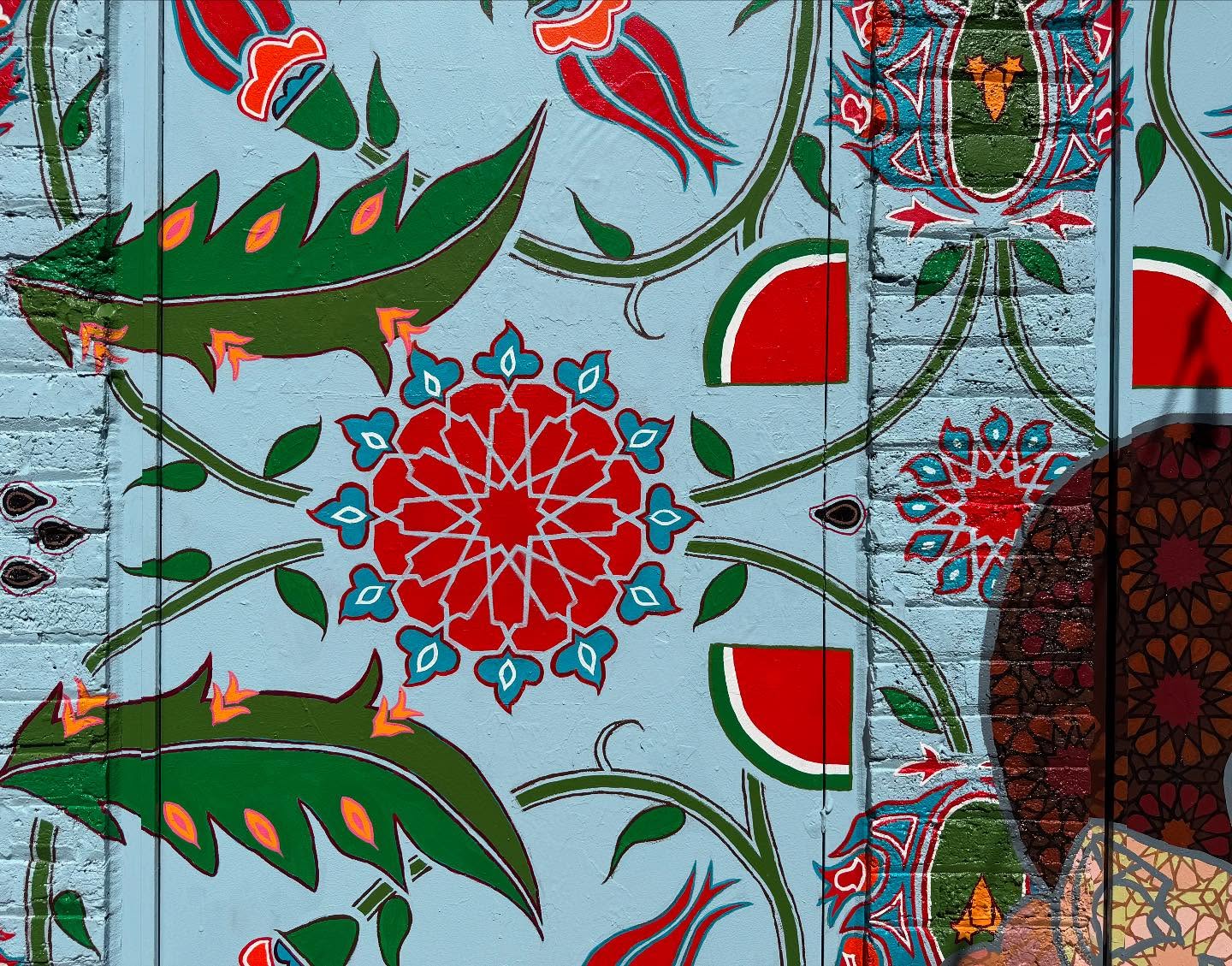
Last year Kasir began receiving messages asking what happened to his mural. “I found out that it was behind a fence, barricaded behind local businesses’ garbage dumpsters. I felt this was very disrespectful.” As the Gaza war continued, Kasir saw it as another “silencing of an Arab voice at a time when we found that our voices were being purposefully silenced.”
After he complained, the business improvement district offered Kasir the opportunity to paint a new mural. He had already completed a diptych of a Palestinian family for the Baird Center and decided to paint a mural on the destruction of Gaza. “I made it about what’s happening right now,” he said. “The city needed a mural that represented a free Palestine. There needs to be a conversation about that. My point is to represent the people, to see them as human beings, as a mother who cares for her son as much as any mother.”
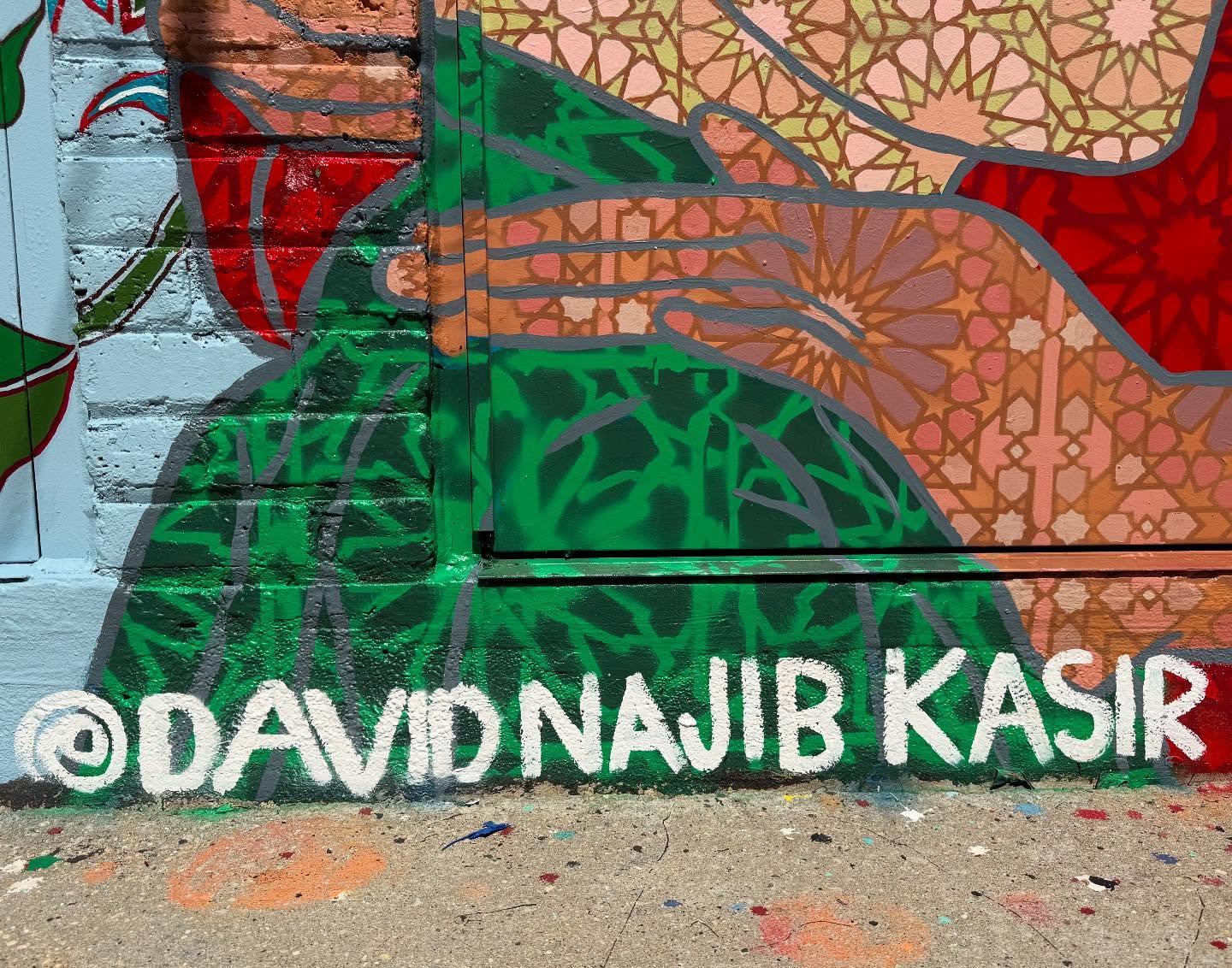
Kasir had the opportunity to attend schools in New York and San Francisco, as well as the Art Institute of Chicago, but opted instead for MIAD. “In my way of thinking at the time, Milwaukee was far enough away from Chicago, but not too far away from my family,” he said. Kasir enrolled at MIAD in 1998 and graduated in 2001.
He stayed in Milwaukee to start a family, and although he once had dreams of moving to New York, he has few regrets. Visiting artist friends in New York several years ago, and seeing the expense and difficulties of their lives, was “an eye-opening moment,” he recalled. “I probably would’ve moved back to Chicago.”
Although he still insists that Chicago is “the best city in the world,” he added, “I love Milwaukee. It’s growing and it’s got many cultures. And I love cities. Cities are where you can learn about so many cultures and other people.”


